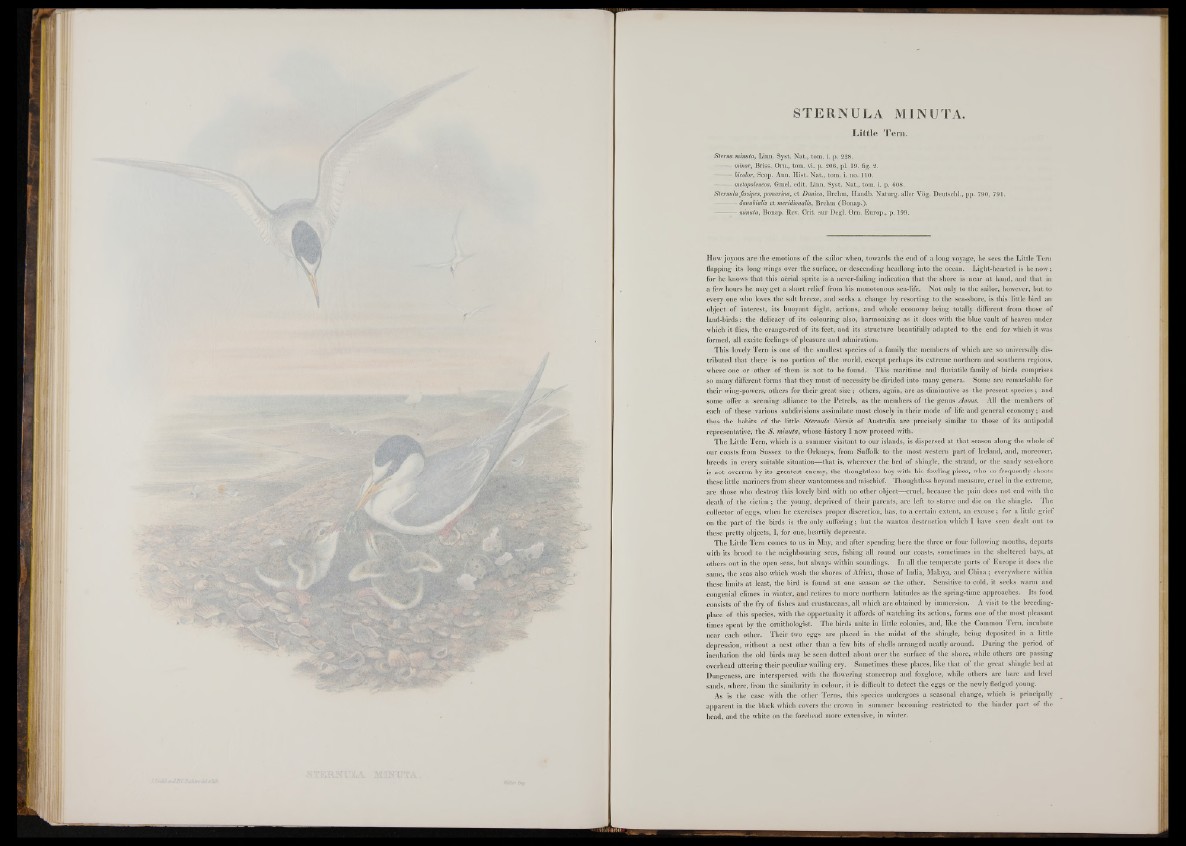
STERNULA MINUTA.
Little Tern.
Sterna minuta, Linn. Syst. Nat., tom. i. p. 228.
— minor, Briss. Orn., tom. vi. p. 206, pi. 19. fig. 2.
— .bicolor, Scop. Ann. Hist. Nat., tom. i. no. 110.
— metopoleucos, Gmel. edit. Linn. Syst. Nat., tom. i. p. 608.
Sternula fissipes, pomarina, et Danica, Brehm, Handb. Naturg. aller Vog. Deutschl., pp. 790, 791.
— danubialis et meridionalis, Brehm (Bonap.).
--------- minuta, Bonap. Rev. Crit. sur Degl. Ora. Europ., p. 199.
How joyous are the emotions o f the sailor when, towards the end o f a long voyage, he sees the Little Tern
flapping its long wings over the surface, or descending headlong into the ocean. Light-hearted is he now;
for he knows that this aerial sprite is a never-failing indication that the shore is near at hand, and that in
a few hours he may get a short relief from his monotonous sea-life. Not only to the sailor, however, but to
every one who loves the salt breeze, and seeks a change by resorting to the sea-shore, is this little bird an
object of interest, its buoyant flight, actions, and whole economy beiug totally different from those of
land-birds: the delicacy of its colouring also, harmonizing as it does with the blue vault of heaven under
which it flies, the orange-red o f its feet, and its structure beautifully adapted to the end for which it was
formed, all excite feelings of pleasure and admiration.
This-lovely Tern is one of the smallest species o f a family the members o f which are so universally distributed
that there is no portion o f the world, except perhaps its extreme northern and southern regions,
where one or other of them is not to be found. This maritime and fluviatile family of birds comprises
so many different forms that they must o f necessity be divided into many genera. Some are remarkable for
their wing-powers, others for their great size; others, again, are as diminutive as the present species ; and
some offer a seeming alliance to the Petrels, as the members of the genus Anous. All the members of
each of these various subdivisions assimilate most closely in their mode o f life and general economy; and
thus the habits of the little Sternula Nereis o f Australia are precisely similar to those of its antipodal
representative, the S. minuta, whose history I now proceed with.
The Little Tern, which is a summer visitant to our islands, is dispersed at that season along the whole of
our coasts from Sussex to the Orkneys, from Suffolk to the most western part of Ireland, and, moreover,
breeds in every suitable situation—that is, wherever the bed o f shingle, the strand, or the sandy sea-shore
is not overrun by its greatest enemy, the thoughtless boy with his fowling-piece, who so frequently shoots
these little mariners from sheer wantonness and mischief. Thoughtless beyond measure, cruel in the extreme,
are those who destroy this lovely bird with no other object—cruel, because the pain does not end with the
death of the victim; the young, deprived of their parents, are left to starve and die on the shingle. The
.collector o f eggs, when he exercises proper discretion, has, to a certain extent, an excuse; for a little grief
on the part of the birds is the only suffering; but the wanton destruction which I have seen dealt out to
these pretty objects, I, for one, heartily deprecate.
The Little Tern comes to us in May, and after spending here the three or four following months, departs
with its brood to the neighbouring seas, fishing all round our coasts, sometimes in the sheltered bays, at
others out in the open seas, but always within soundings. In all the temperate parts o f Europe it does the
same, the seas also which wash the shores of Africa, those of India, Malaya, and China; everywhere within
these limits at least, the bird is found at one season or the other. Sensitive to cold, it seeks warm and
congenial climes in winter, and retires to more northern latitudes as- the spring-time approaches. Its food
consists o f the fry o f fishes and crustaceans, all which are obtained by immersion. A visit to the breeding-
place o f this species, with the opportunity it affords o f watching its actions, forms one o f the most pleasant
times spent by the ornithologist. The birds unite in little colonies, and, like the Common Tern, incubate
near each other. Their two eggs are placed in the midst o f the shingle, being deposited in a little
depression, without a nest other than a few bits o f shells arranged neatly around. During the period of
incubation the old birds may be seen dotted about over the surface of the shore, while others are passing
overhead uttering their peculiar wailing cry. Sometimes these places, like that o f the great shingle bed at
Dungeness, are interspersed with the flowering stonecrop and foxglove, while others are bare and level
sands, where, from the similarity in colour, it is difficult to detect the eggs or the newly fledged young.
As is the case with the other Terns, this species undergoes a seasonal change, which is principally
apparent in the black which covers the crown in summer becoming restricted to the hinder part o f the
head, and the white on the forehead more extensive, in winter.